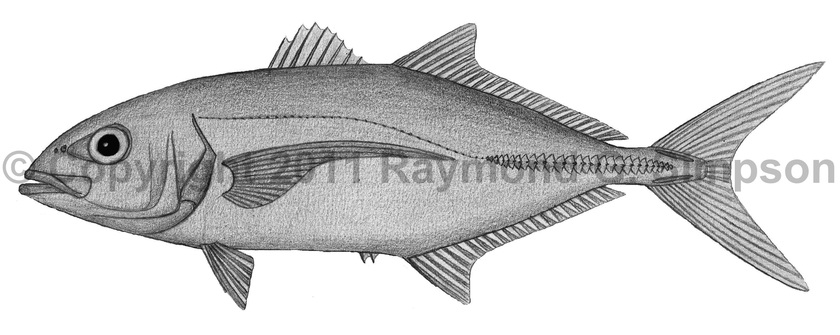
Common Name
Yellow Jack
Year Described
Cuvier & Valenciennes, 1833
Identification
Dorsal Fin: 7 spines in first lobe, followed by I, 25-28
Anal Fin: 2 spines separate from rest, followed by I, 21-24
Pelvic Fin: I, 5
Gill Rakers: 6-9 upper, 18-21 lower
Vertebrae: 10 precaudal, 14 caudal
Elongate, compressed, and fairly deep-bodied, with a large head, blunt snout, and a moderate eye (6.0-6.8 times in HL). Adipose eyelid moderate. Snout long; jaw does not reach anterior margin of eye. Teeth villiform, usually in a single row in both jaws (widest anteriorly). Pectoral fins falcate, longer than head. Spiny dorsal fin lower than lobe of second dorsal fin. Anterior lobe of second dorsal and anal fin slightly raised. Tail deeply forked. Lateral line with an shallow anterior arch and a straight posterior portion with 22-28 scutes. Small cycloid scales on entire body, including entire chest. Bilateral caudal keels present. Hyperostosis absent.
Color
Bluish dorsally, silvery to whitish over rest of body. There is often a golden sheen to parts of the body, especially the dorsal midline, along the lateral line, the ventral midline, a stripe through the eye, and around the mouth/maxilla. Fins are pale to yellow. Juveniles pale with yellow marbling/body bars and a black band through the eye.
Size
Common to 45cm. Maximum size to 90cm.
Habitat
Offshore pelagic or around outer reefs. Solitary or in small groups. Juveniles associate with flotsam and seagrass beds.
Range
Massachusetts to E. Brazil, including Bermuda and the Caribbean islands.
References
Smith-Vaniz, W.F. 2003. Carangidae (pp 1426-1468). In: Carpenter. 2003. The living marine resources of the Western Central Atlantic v. 3.